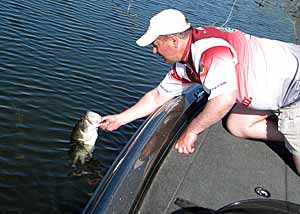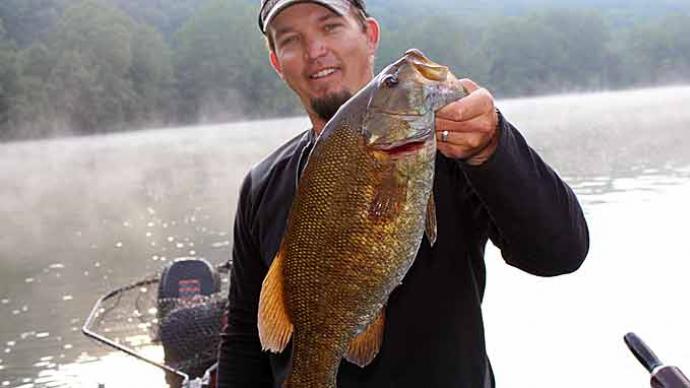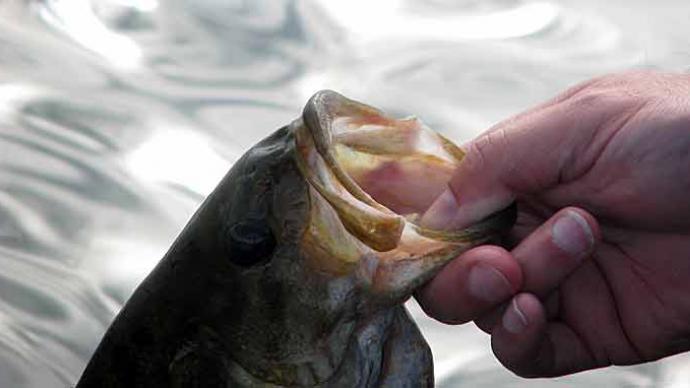
The "Do-Nothing" technique is enjoying a recent resurgence among weekend anglers. Perhaps, as is typically the case with innovative techniques, this is merely a fad. However, one fact is certain: these "do-nothing" styles produce when properly used. So are you "doing nothing" the correct way? Despite the name's simplicity, there are several rights and wrongs when fishing the various do-nothing techniques. The following tips will ensure that you catch something when doing nothing.
The first lure to incorporate the "do-nothing" technique was Charlie Brewer's Sliders. The idea behind this lure is quite simple: put a slender plastic trailer on a flat jig head, cast it out, and reel it at a steady pace. Today, the technique of "doing nothing" has been taken a step further to allow lures to sit on the bottom of a lake for minutes. Many anglers do not have the patience to fish this technique, but it's a proven producer when the going gets tough. Typical do-nothing lures in this style include tubes, jigs, and plastics (particularly creature baits). For this article, we'll leave Mr. Brewer's famous lures alone and focus on the "do-nothing" technique of leaving lures on lake/river bottoms.
This technique is highly advantageous when used in cold water (36-48 degrees) and during lulls in barometric pressure change when fish are typically less active. My favorite time to use such techniques is when the water is roughly 38-40 degrees. The bass are not terribly active and won't move once you've located them. Now it's just a matter of putting this "dying" annoyance in their interest zone.
The equipment and terminal tackle used with such rigs is the most crucial part of fishing this method. Sensitivity is paramount, and as we all know, we constantly search for the most sensitive equipment.
ROD: Longer and higher modulus graphite composition will translate into the greatest sensitivity. Naturally, there are tradeoffs to using extremely high modulus rods, notably longer rods. High modulus rods are often very brittle, prone to failure, expensive, and do not allow a forgiving fight.
This last point is most prevalent in this style of fishing - often, hooksets will occur pre- or post-maturely, resulting in a poorly hooked fish. Having a forgiving rod can often mean the difference between landing the tourney winner or finishing out of the money.
For this reason, I recommend using rods that incorporate a carbon layer to assist in fiber orientation - this means a highly sensitive yet stronger and more forgiving rod than strict graphite. For example, St. Croix makes Legend Tournament 6'8" and 6'10" spinning rods with a medium extra-fast design. I have found these rods ideal for the do-nothing style of fishing. The medium extra-fast action allows for the slightest pick-up to be detected and, most importantly, incorporates a forgiving action to fight the fish.
LINE: With the latest craze surrounding the strength and durability of fluorocarbon and copolymer hybrid lines, it seems mono has been left in the dust. I use mono for roughly 90% of my fishing; I only use high-tech lines when necessary. Mono is the best all-around choice for several reasons.
The first is its stretch factor. When fishing in cold water, we all know the fish are less active, meaning they are not likely to pound your offering. If a fish picks up my lure, chances are it's out of curiosity, not hunger. If something does not feel right, he'll probably spit it out, and I never knew he was even there. Mono offers more stretch, meaning there's a smaller chance Mr. Bass will feel resistance. This gives me a better chance to drop my rod, give him some line, let him turn, and then set the hook (Note: with smallmouth, do not drop your rod tip - based on mouth design, if they pick up and you set the hook, you'll typically have them). Secondly, mono allows for a more forgiving fight.
Many of you may disagree and claim that a more sensitive copolymer hybrid or fluorocarbon is a better way to detect the bite. Remember, if it's easier to feel what your line tells you, it's easier for fish to feel that same pressure. Rely on your rod to feel fish. Your second indicator will be watching your line. This is where mono again proves more valuable than fluorocarbon; it's easier to see and has more buoyancy than the other lines, allowing slack to sit on the surface while you watch for a pick-up.
Now I will concede there are times when I will use fluorocarbon over mono, particularly in clear water. What is interesting to note is that in cold water, bass are less likely to locate in very clear water. Darker water, even deep darker water, tends to absorb more light, meaning more warmth for fish. It also means more cover for these elusive fish. However, if you locate fish in gin-clear water, switching to fluorocarbon is wise.
I recommend using the lightest line possible for any application. If you are fishing spoils or rip rap, you may need upwards of 12-pound test. I tend to use 8 pound as a general line and use heavier line on an as-needed basis. I've been using Izorline for some time and found their mono a great choice. It tends to have a thinner diameter than everyday brands, meaning a more natural appearance. It's one of those lines few know about, but many pros use.
LURE: The biggest rule here is to use the lightest weight you can get away with. If you are fishing rivers, flowing reservoirs, or tidal waters, you may need more weight to keep your lure from moving too much with the current. Otherwise, you'll be frustrated watching your line move all day long.
In terms of tube jigs, I use Bite Me Tackle Flat Eye Tube Jig Heads - they're a heck of a lot cheaper than buying at a local dealer, and they are made with ultra-sharp Gamakatsu hooks. I'd recommend using tube colors that resemble natural forage. I've often found that many colors will work, and it's more about appealing to bass' natural curiosity than their instinct to eat. Typically I stick to crawdad colors. Conversely, there have been times when a red or pink color works well - most likely as an agitating color.
In terms of jigs, I prefer ¼ oz Missile Jigs Head Banger Football Jigs. I like to rig these with pork because pork does not stiffen up in cold water, and its buoyancy helps maintain a more lifelike appearance by moving with the water.
I usually do not bother with noisemakers. Occasionally, I'll leave rattles on jigs if the fish are more active, but I have never noticed a huge difference either way. However, I will use scents. Again, I want to appeal to a fish's curiosity - if that means he'll hang to it that lure a second longer to figure out what that nasty taste is, then I'll use that product. These decisions are up to the individual fishing. If you feel they help you, then use them.
The Cast
I recently read an article in a magazine focusing on the importance of making longer casts when fishing is tough. Unfortunately, with cold water, often, this is not the answer. With the "do-nothing" technique, the furthest you'll want to cast is roughly 35-40 feet. There are three reasons for this.
First, the closer that lure is, the more you can see the line move and feel what's going on below the surface. Secondly, each cast takes a very long time to retrieve; you do not want to wait 15 minutes just to get your lure back to the boat. Finally, before using this technique, you should know where the fish are located. It is not a fish-finding technique - it is a fish-catching technique. There is no reason to be covering water 75 feet away.
The Technique
The do-nothing technique is quite simple, but there are some basic guidelines you should follow:
- After the cast, let the lure settle on the bottom. You'll often have a bite on this initial drop, so pay attention every time you cast!
- You'll want to lock your rod at a 45-60 degree angle. Keep in mind that your rod is most sensitive from the 10 to 11 o'clock positions - moving outside of this zone takes all sensitivity from your rod and places it on your line. Without a doubt, a fish will feel a direct connection with your reel through your line alone; with the pole in the proper position, the fish now feels a more forgiving pole, and you, in turn, feel the fish.
- For the retrieve itself, do not move the rod tip. ONLY MOVE THE REEL HANDLE! I won't drag this lure because dragging moves your pole from its most advantageous 45-60 degree position.
- Occasionally, giving the lure a slight shake may help entice a bite. Remember, you want this lure to appeal to the fish's curiosity or simply annoy the fish so that it strikes.
- Remember that each reel takes in roughly 18 inches of line, so reeling a ¾ crank every 20 to 30 seconds is what I recommend (naturally, this depends on your reel).
- The retrieve should take roughly three to four minutes, perhaps shorter or longer as conditions dictate. If the fish are extremely lethargic, you may need just to let that lure sit there and agitate them for several minutes before they pick it up.
- Do not keep an ultra-tight line. This will keep constant pressure on the lure, and any finicky fish will certainly not approve; additionally, a tight line tends to make a lure "jump" when the fish picks it up. Ideally, you'll want to have some slack line lying on the surface to watch your line.
- When shaking the lure, any ticks or mushy feeling may be a fish - set the hook. When watching the slack line, any line movement is usually a fish. Sometimes fish inhale the lure and simply sit with it, not allowing you to see any line movement. This is where an occasional shake of the lure can help reveal any takers but do not overdo the shaking. It's called "do-nothing" for a reason! You will not catch every fish that picks up your lure, but doing the right things will help improve the odds in your favor.
- In terms of setting the hook, I do not employ a hard set. I instead opt for a gentle sweep, pending on which way the fish is moving with my bait. I do not want to rip the lure from his mouth, so I set it in the opposite direction he is heading. If he has come up behind the lure and is swimming forwards or standing still, I lift up on my rod. Remember that it doesn't take much to set the hook with the thinner diameter line. Picking up the pole is enough wallop to punch a sharp hook into the fish's mouth.
Finally, patience is the greatest virtue to have when fishing the do-nothing. I encourage anglers to take a break from it when they've gone without a fish. Pick up a Carolina rig and, cover some water, find new fish. Fishing the do-nothing can be draining, and you're sure to miss a pick-up if you get bored. So keep your head in the game and stay patient. Good things will come. Tight lines, everyone.
BassResource may receive a portion of revenues if you make a purchase using a link above.




